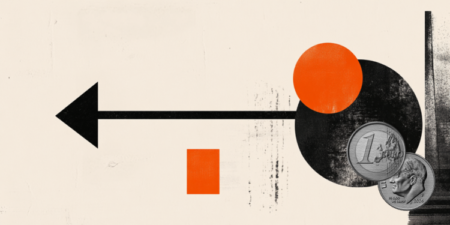- The Japanese Yen continues to attract safe-haven flows amid the escalating US-China trade war.
- Hopes that Japan might strike a trade deal with the US contribute to the bid tone around the JPY.
- The divergent BoJ-Fed policy expectations provide an additional boost to the lower-yielding JPY.
The Japanese Yen (JPY) sticks to its positive bias at the start of a new week and remains close to the highest level since late September 2024 touched against a broadly weaker US Dollar (USD) last Friday. Investors remain worried about the escalating US-China trade war and its impact on the global economy, which continues to underpin the safe-haven JPY. Adding to this, the optimism over a possible US-China trade deal turns out to be another factor lending support to the JPY.
Meanwhile, markets have been pricing in the possibility that the Bank of Japan (BoJ) will continue raising interest rates in 2025 amid the broadening inflation in Japan. This marks a big divergence in comparison to bets that the Federal Reserve (Fed) will lower borrowing costs at least three times by the end of this year, which keeps the USD depressed near a multi-year low and further benefits the lower-yielding JPY. That said, improving global risk sentiment caps any further JPY gains.
Japanese Yen bulls retain control as escalating US-China trade war boosts safe-haven demand
- China’s 84% tariffs on US goods took effect on Thursday, while US President Donald Trump hiked duties on Chinese imports to an unprecedented 145%. The developments fuel worries about the potential economic fallout from the escalating trade war between the world’s two largest economies and drive some safe-haven flows toward the Japanese Yen.
- Investors remain optimistic about a positive outcome from US-Japan trade talks. In fact, Trump said last week that tough but fair parameters are being set for a negotiation. Adding to this, US Treasury Secretary Scott Bessent said that Japan may be a priority in tariff negotiations, fueling hopes for a possible US-Japan trade deal and further underpinning the JPY.
- Japanese Prime Minister (PM) Shigeru Ishiba warned on Monday that “US tariffs have the potential to disrupt the world economic order.” Separately, Japan’s Finance Minister Shunichi Kato said that “the US and Japan share the view that excessive FX volatility is undesirable.” Moreover, Japan’s Economy Minister Ryosei Akazawa stated that “the FX issues will be dealt with between Finance Minister Kato and US Treasury Secretary Scott Bessent.”
- Meanwhile, the Bank of Japan’s preliminary report released last Thursday showed that annual wholesale inflation accelerated to 4.2% in March. This is a sign of persistent cost pressures, which, along with strong wage growth, should contribute to mounting domestic inflationary pressure and allow the BoJ to continue raising interest rates this year.
- In contrast, the latest reading of the US Consumer Price Index indicated that inflation slowed sharply in March. This comes on top of the weakening confidence in the US economy and should allow the Federal Reserve to resume its rate-cutting cycle. Moreover, market participants are now pricing in the possibility of 90 basis points of rate cuts by the end of this year.
- The divergent BoJ-Fed policy expectations turn out to be another factor that benefits the lower-yielding JPY. The US Dollar, on the other hand, languishes near its lowest level since April 2022 touched on Friday. This, in turn, drags the USD/JPY pair back closer to a multi-month low during the Asian session on Monday and supports prospects for further losses.
USD/JPY bears might now wait for break below the 142.00 mark before placing fresh bets
From a technical perspective, the daily Relative Strength Index (RSI) is on the verge of breaking into the oversold territory and warrants some caution for bearish traders. Hence, it will be prudent to wait for some near-term consolidation or a modest bounce before positioning for an extension of over a three-month-old downtrend. In the meantime, the 142.00 mark, or a multi-month low touched on Friday, could offer some support to the USD/JPY pair. A convincing break below could drag spot prices towards the 141.65-141.60 intermediate support en route to the 141.00 mark. Some follow-through selling below the 140.75 zone might expose the September 2024 swing low, around the 140.30-140.25 region, before the pair eventually drops to the 140.00 psychological mark.
On the flip side, any attempted recovery back above the 143.00 mark is likely to confront stiff resistance near the 143.50-143.55 zone. The subsequent move up could lift the USD/JPY pair to the Asian session peak, around the 144.00 round figure, which if cleared decisively might trigger a short-covering rally to the 144.45-144.50 horizontal resistance. The momentum could extend further towards reclaiming the 145.00 psychological mark en route to the 145.50 zone and the 146.00 round figure.
Bank of Japan FAQs
The Bank of Japan (BoJ) is the Japanese central bank, which sets monetary policy in the country. Its mandate is to issue banknotes and carry out currency and monetary control to ensure price stability, which means an inflation target of around 2%.
The Bank of Japan embarked in an ultra-loose monetary policy in 2013 in order to stimulate the economy and fuel inflation amid a low-inflationary environment. The bank’s policy is based on Quantitative and Qualitative Easing (QQE), or printing notes to buy assets such as government or corporate bonds to provide liquidity. In 2016, the bank doubled down on its strategy and further loosened policy by first introducing negative interest rates and then directly controlling the yield of its 10-year government bonds. In March 2024, the BoJ lifted interest rates, effectively retreating from the ultra-loose monetary policy stance.
The Bank’s massive stimulus caused the Yen to depreciate against its main currency peers. This process exacerbated in 2022 and 2023 due to an increasing policy divergence between the Bank of Japan and other main central banks, which opted to increase interest rates sharply to fight decades-high levels of inflation. The BoJ’s policy led to a widening differential with other currencies, dragging down the value of the Yen. This trend partly reversed in 2024, when the BoJ decided to abandon its ultra-loose policy stance.
A weaker Yen and the spike in global energy prices led to an increase in Japanese inflation, which exceeded the BoJ’s 2% target. The prospect of rising salaries in the country – a key element fuelling inflation – also contributed to the move.
Read the full article here
















